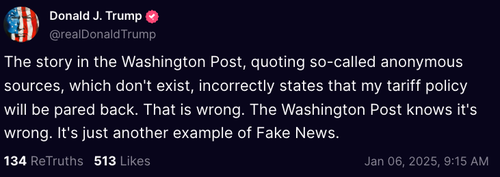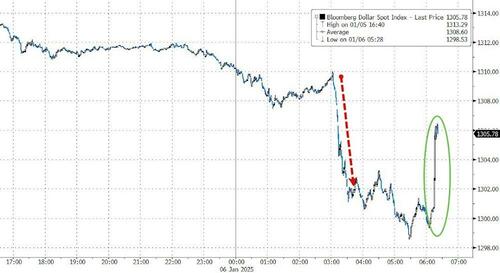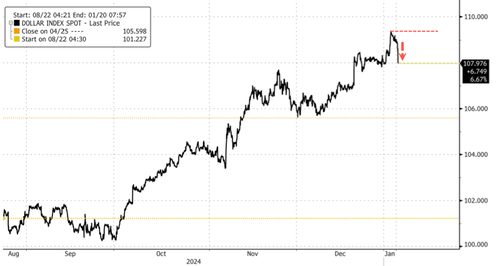Dollar Reverses Losses After Trump Blasts WaPo's "Fake News" Tariff Report
Update (0930ET):
On Truth Social, President-elect Donald Trump blasted the Washington Post for "quoting so-called anonymous sources, which don't exist, incorrectly states that my tariff policy will be pared back."
"That is wrong. The Washington Post knows it's wrong. It's just another example of Fake News," the former president said.
Right away, we called out this malarkey.
2 hours
— zerohedge (@zerohedge) January 6, 2025
From Trump: "The story in the Washington Post, quoting so-called anonymous sources, which don't exist, incorrectly states that my tariff policy will be pared back. That is wrong. The Washington Post knows it's wrong. It's just another example of Fake News." https://t.co/QWdusUhnkD
WaPo's fake news reporting sent the Bloomberg Spot Dollar Index tumbling by over 1%, one of the biggest intra-day drops since 2023.
Thanks WaPo for the 300 pips,
— zerohedge (@zerohedge) January 6, 2025
you fake news garbage https://t.co/4yp0fG7lY0
There is nothing like fake news from legacy corporate media to start the week.
Investigate WaPo for market manipulation on behalf of hedge fund "anonymous sources" https://t.co/UnzYzfb7O9
— zerohedge (@zerohedge) January 6, 2025
* * *
The US dollar slid on Monday after reports emerged that President-elect Donald Trump's aides are considering a revised, less strict tariff plan. While Trump's 2024 campaign promised a universal tariff on most imports, the new proposal would focus instead on imposing tariffs specifically on critical imports, according to the Washington Post, citing three people familiar with the plan.
Trump repeatedly claimed during the campaign that he would implement a "universal" 10% to 20% import tariff on all foreign-made goods into the United States. He also spoke about a 60% import tariff on Chinese goods and a 100% tariff on all imported cars.
According to WaPo:
Two weeks before Trump takes office, his aides are still discussing plans to impose import duties on goods from every country, the people said.
But rather than apply tariffs to all imports, the current discussions center on imposing them only on certain sectors deemed critical to national or economic security — a shift that would jettison a key aspect of Trump's campaign pledge, at least for now, said the people, who cautioned that no decisions have been finalized and that planning remains in flux.
While the Biden administration has not rescinded most of the existing tariffs enacted under Trump 1.0, a universal blanket of tariffs on all imports would have been part of the 'America First' trade policies. However, it seems unlikely that Trump would abandon such a key policy initiative right out of the gate.
The sources familiar with the potential tariff change were unclear about which imports would be affected.
More from WaPo...
Preliminary discussions have largely focused on several key sectors that the Trump team wants to bring back to the United States, the people said. Those include the defense industrial supply chain (through tariffs on steel, iron, aluminum and copper); critical medical supplies (syringes, needles, vials and pharmaceutical materials); and energy production (batteries, rare earth minerals and even solar panels), two of the people said.
WaPo's report sent the Bloomberg Dollar Index tumbling early Monday, breaking below $108. This marked a sharp reversal following the multi-month 9% rally that started at the beginning of October.
Here's Bloomberg's Markets Live desk's take:
The dollar’s reaction to the Washington Post’s report that the incoming US administration might consider targeting import taxes at certain industries, rather than across the board, shows how much of the currency’s strength is based on anticipation of broad, and early, tariffs. It also suggests that the dollar’s recent strength is more dependent on fiscal rather than monetary policy. Bloomberg’s gauge of the dollar is falling the most since November.
Lots of currencies are benefiting from the dollar slump, which makes sense given the Washington Post report was vague as to which industries might be exempt. The euro, pound and Mexican peso are all at their strongest levels of the year.
That so much of the dollar’s strength should be reliant on tariff policy has implications for inflation and rates as well. All things being equal, adding taxes to imports pushes up consumer prices. But how much of that increase feeds through into living costs depends on lots of factors, notably how much pain companies are prepared to absorb (lots, if you cut their taxes elsewhere, presumably) and how much the currency rises. Today’s moves will shed light on how much of the tariff pain would be softened by a stronger dollar.
There is no confirmation from the incoming Trump administration regarding the validity of WaPo's report.
How long until Trump denies all of this?
— zerohedge (@zerohedge) January 6, 2025
*TRUMP MULLS 'UNIVERSAL' TARIFF PLANS FOR CRITICAL IMPORTS: WAPO
For all we know, this could be a case of a dollar trader leveraging the media outlet.




